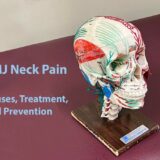Professional Jaw Pain Treatment Integrated with Self-care

How to Gain Jaw Pain Relief with Professional Treatment
When needing caring, professional treatment for jaw pain relief, a pain relief specialist can oversee your jaw’s diagnosis and on-going care.
Jaw pain is too often a devastating condition that affects a person’s ability to eat and speak. Multiple causes are commonly behind jaw pain, from your sinuses and ears, an injury, to your teeth or jaw itself. This adds to the challenge of deciphering if your jaw pain is because of a jaw issue or something else. Once we understand your personal diagnosis, the MN Head and Neck Pain Clinic can help you establish a self-help routine at home.
How do Professionals Assess Jaw Pain?
Your doctor or dentist may refer you to an orofacial pain specialist who is best at discuss your symptoms, examining your jaw and setting up the best path forward. Because our bodies are marvelously connected, it means also assessing neck pain factors. Managing jaw pain is a joint partnership between you and your doctor.
A pain specialist at the Minnesota Head and Neck Clinic does the following:
- Assess what happens to your jaw area when you open and close your mouth.
- Examines the range of motion in your jaw.
- Perceives how well your connective soft tissues function.
- Performs different tests that identify the location of your pain or discomfort.
How do Orofacial Pain Specialists Help with Severe Jaw Pain?
Below is a partial list of medical steps that may be needed to set-up an effective jaw pain treatment and give you pain relief:
- Dental X-rays to inspect your teeth and jaw for issues like a TMJ Disorder.
- A CT scan that gives us more precise images and details of the bones involved in the joint.
- An MRI to diagnose problems with how the jaw joint’s disk or surrounding soft tissue functions and could be improved.
- A TMJ arthroscopy may be recommended for the diagnosis of a TMJ disorder.
What Non-Prescription Therapies are Commonly Used to Reduce Jaw Pain?
Your treating physician may recommend the following non-drug therapies which are commonly used to reduce jaw pain:
- Oral splints or mouth guards, which are commonly called occlusal appliances, have proved helpful to people with jaw pain. It means wearing a soft-to-firm device that is inserted over the teeth and then monitored to assess progress.
- A Physical therapy plan. In addition to daily exercises centered on how to stretch and strengthen jaw muscles, treatments might include ultrasound, moist heat, and/or ice.
- On-going Counseling. You will likely want the benefits of ongoing education, emerging care options, and counseling to know if you are on-track. By understanding the factors and behaviors that may trigger or add to your pain, you can avoid them. For example, if teeth clenching or grinding, leaning on your chin, persistently biting your fingernails, stress, or difficulty relaxing are contributing factors, there is help through professional pain management.
How can Someone Suffering from Jaw Pain do Self-Treatment?
To establish an effect self-treatment plan for jaw pain, remember the 80/20 Rule
80% of success in healing pain conditions is based on self-care while 20% is based on treatments. Our recommended self-care treatment will combine your healthcare needs with a doctor’s oversight. Self-care jaw pain exercises are easy to implement, inexpensive, and typically effective at reducing jaw pain while improving jaw function. Typically, an integrated self-care treatment HEALS jaw pain with these 5 steps:
1. HEALS – Heat/ice/massage; Exercise; Analgesics; Lifestyle; and Strain and stress reduced. Heat, ice & massage: Apply heat or ice to sore muscles and joints. This will help improve healing, reduce the sensitivity of muscles and joints, and encourage healing. Trigger Point Massage with a thumb, finger, or knobble for a few minutes to provide a deep massage to the tender trigger points within tight muscle bands. They will reduce their tenderness, relax the muscles, and reduce the pain.
2. Exercise: Stretching, strengthening, and posture of jaw. For stretching, gently and gradually increase the range of motion by placing two fingers between your front teeth for a count to 10: Rest and repeat 6 times. When 2 fingers are comfortable, then increase to 2 knuckles, then 3 fingers to full range of motion. To strengthen, push the jaw to each side without moving it. Repeat 6 times.
Balanced relaxed postures. Jaw: Keep your lips closed, teeth apart, tongue up in the “n” position, breath through the nose, and let jaw hang like a hammock between 2 trees. Sitting: Sit with bottom back against chair then lean back with head up balanced over the neck, and shoulders relaxed back and down. Standing: Chest up, head up, balanced over the neck, and shoulders relaxed back and down. Be mindful of maintaining balanced relaxed postures during the day.
3. Analgesics: Use anti-inflammatory and pain-reducing medications as needed. Short-term use of over-the-counter ibuprofen, naproxen, acetaminophen, or aspirin (without caffeine) can reduce inflammation, joint, and muscle pain. Consider using a combination of ibuprofen and Tylenol before bedtime to relieve pain with sleep. Avoid opioid medications since it increases pain over time.
4. Lifestyle: Eat a pain-free softer diet and get a good night’s sleep. Eat a soft diet to reduce strain on the jaw. A soft diet consists of well-cooked or soft protein foods, fruits, vegetables, eggs, smoothies, soups, and yogurt. Eat smoothies by using a blender to blend fruits and vegetables to protect the jaw until it heals. Make sure your diet includes healthy portions of protein and vegetables.
What lifestyle changes are needed to reduce jaw pain?
Avoid sugar and simple carbohydrates that cause inflammation. Avoid caffeine that causes headaches and sleep disorders. Avoid tough chewy foods; cut foods into small bites. Do not chew gum!
Improve sleep with a regular pro-sleep routine. Set up a sound sleeping environment with a cool, quiet, and dark sleeping room. Use bed only to sleep in. Avoid caffeine in coffee, tea, and soft drinks. Get a comfortable semi-firm mattress and squishable pillow. Reduce stimulating activities before bed including computer work, video, TV drama, and exercising. Sleep on your side or back with a pillow between or under your knees. Accept interruptions as normal and go back to getting needed sleep. Request help for any sleep apnea issues.
5. Strain reduced to jaw: Avoid muscle tensing habits that put strain on the muscle and joints. Never touch your upper and lower teeth together except during eating. Use reminders such as stickers or timers. If jaw pain or oral habits are noticed, replace negative habits with positive habits.
What is TATU and what does it stand for?
TATU stands for: “Teeth apart, Tongue up”. The tongue is placed in the “n” position, let your jaw relax, keep eye lips closed, and breathe through your nose. It is used by many for self-care jaw pain management. Jaw pain can be caused by factors that aren’t due to and underlying disease. This raises the question, “What daily bad habits should be avoided to avoid jaw pain?”
Things people do that may generate unwanted jaw pain:
- Teeth clenching and grinding (bruxism).
- Touching or resting the teeth together.
- Biting cheeks, lips, or tongue.
- Pushing the tongue against the teeth.
- Hard chewy foods and biting objects like pens.
- Tensing your jaw or pushing it forward or to the side.
- Jaw strain from musical instruments, snorkel, scuba.
- Opening mouth too wide too wide or too long.
Be careful with the jaw. Avoid injury to the jaw by avoiding excessively prolonged opening with yawning, dental visits, singing, and biting hard foods, such as hard breads, tough steaks, candy, and gum. Chewing on both sides alternatively. Use a pain log to review daily activities that aggravate the pain and modify these activities. Untreated jaw pain can further amplify a TMJ disorder and add to other potential problems.
Stress Reduced: Practice calming stress reactions by taking a PAUSE to take a few deep breaths quiet your mind, and practice relaxation. PAUSE means Pause to Assess, Understand, Start new, and Enjoy the moment. This helps reduce your reactions to stressful life events and decreases tension in the jaw and oral habits such as clenching.
Is On-going Professional Needed for Persistent Jaw Pain?
The goal is to help you overcome your jaw pain in time. While a professional diagnosis of your jaw is important, conservative pain treatments are effective for most people. “Because the most common jaw joint and muscle problems are temporary and do not get worse, simple treatment may be all that is necessary to relieve discomfort”, according to the National Institute of Dental and Craniofacial Research.
If you have additional questions about your jaw pain, you are not alone. Researchers along with pain specialists are seeking further answers to what causes painful jaw conditions and what the best treatments are. Our pain managers can best answer your remaining questions in person.
Pathophysiology, clinical assessment, and our imaging evaluation, which may include modern MR imaging and CBCT, will give you clarity when considered in detail. Our multidisciplinary team provides successful management of jaw pain for many referring dentists, surgeons, primary care doctors, pain doctors, and allied health professionals. This includes help for patients with TMD and Fibromyalgia.
CONCLUSION
Tolerating persisting jaw pain without seeing a jaw pain specialist puts you at risk of progressive arthritic changes inside the jaw joints. Early treatment is highly recommended to sidestep possible long-term damage. Sometimes people experience tooth pain and we find it’s caused by hidden TMJ issues. Once these are professionally diagnosed, your self-care at-home treatment can be more effective. When we find that an in-office appointment is better served by a telemedicine appointment, we’ll make that recommendation.
Call and request your assessment with a doctor on our team of pain relief specialists today:
Burnsville (952) 892-6222, Plymouth: (763) 577-2484, St. Cloud (763) 577-2484 or St. Paul: (651) 332-7474



